Experimental Study of the Planting Uniformity of Sugarcane Single-Bud Billet Planters
Abstract
:1. Introduction
2. Materials and Methods
2.1. Billet Preparation
2.2. Laboratory Experiment
2.2.1. Experimental Evaluation of the Planting Uniformity
2.2.2. Experimental Method
2.2.3. Experiment Design
2.3. Field Experiments
2.3.1. Field Evaluation of the Planting Uniformity
2.3.2. Experimental Method
2.4. Statistical Analysis
3. Results and Discussion
3.1. Analysis of Laboratory Experiment Results
3.1.1. The Effect of the Rotational Speed of the Rake bar Chain on Planting Uniformity
3.1.2. The Effect of Angle of Rake Bar Chain on Planting Uniformity
3.1.3. The Effect of the Number of Billets on Planting Uniformity
3.1.4. Analysis of Orthogonal Test Results
- The miss index Ze reached the minimum at the first level of factor A and the third levels of B and C, respectively, in Figure 10. Considering the interaction of B and C, Ze reached the minimum under multiple combinations of factor B and factor C and was only 2.78% under B2C2;
- According to the three indexes, the optimal combination was A1B2C2. Under this combination, the quality index Zq was 97.22% and the multiple index Zm was 0%, while the miss index Ze was 2.78%.
3.2. Analysis of Field Experiment Results
4. Conclusions
Author Contributions
Funding
Institutional Review Board Statement
Informed Consent Statement
Data Availability Statement
Conflicts of Interest
References
- Singh, A.K.; Singh, P.R. Development of a Tractor Operated Sugarcane Cutter Planter for Mechanisation of Sugarcane Planting in Deep Furrows. Sugar Tech 2016, 19, 1–8. [Google Scholar] [CrossRef]
- Cebim, G.J. Plantio mecânico de cana-de-açúcar (Saccharum spp.): Desempenho operacional e econômico. Stab 2008, 31, 40–47. [Google Scholar]
- Rípoli, M.L.; Rípoli, T.C.; Casagrandi, D.V.; Ide, B.Y. Evaluation of five sugar cane planters. Eng. Agrículture Jaboticabal 2010, 30, 1110–1122. [Google Scholar] [CrossRef]
- Khedkar, M.B.; Kamble, A.K. Evaluation of mechanized planting of sugarcane. Int. J. Agric. Eng. 2008, 1, 136–139. [Google Scholar]
- Deshbhandari, A.; Adesh, K.S.; Karthik, K.S.; Dileep, S.L. Design and Fabrication of Sugarcane Node Cutter Machine. Ph.D. Thesis, CMR Institute of Technology, Bangalore, India, 2021. [Google Scholar]
- Saengprachatanarug, K.; Chaloemthoi, C.; Kamwilaisak, K.; Kasemsiri, P.; Chaun-Udom, S.; Taira, E. Effect of metering device arrangement to discharge consistency of sugarcane billet planter. Eng. Agric. Environ. Food 2018, 11, 139–144. [Google Scholar] [CrossRef]
- Jain, R.; Solomon, S.; Shrivastava, A.K.; Chandra, A. Sugarcane bud chips: A promising seed material. Sugar Tech 2010, 12, 67–69. [Google Scholar] [CrossRef]
- Salassi, M.E.; Breaux, J.B.; Hoy, J.W. Estimated cost differences between whole-stalk and billet sugarcane planting methods in Louisiana. J. Am. Soc. Sugar Cane Technol. 2004, 24, 250–257. [Google Scholar]
- Moslem, N.; Jalil, R.; Ali, K. Fabrication and evaluation of a metering device for a sugarcane billet planter. Yüzüncü Yıl Üniversitesi Tarım Bilimleri Derg. 2015, 25, 1–12. [Google Scholar]
- Galal, M.O.A. A new technique for planting sugarcane in Egypt. Inst. Integr. Omics Appl. Biotechnol. J. 2016, 7, 15–21. [Google Scholar]
- Gujja, B.; Loganandhan, N.; Goud, V.V.; Agarwal, M.; Dalai, S. Sustainable Sugarcane Initiative (SSI) Improving Sugarcane Cultivation. ICRISAT Prasesh India 2009, 1–36. Available online: http://www.agritech.tnau.ac.in/pdf/English%20SSI.pdf (accessed on 18 March 2022).
- Patnaik, J.R.; Singh, S.N.; Sarangi, D.; Nayak, P.K. Assessing potentiality of bud chip technology on sugarcane productivity, profitability and sustainability in real farming situations under south east Coastal Plain Zone of Odisha India. Sugar Tech 2017, 19, 373–377. [Google Scholar] [CrossRef]
- Wang, M.; Liu, Q.; Ou, Y.; Zou, X. Experimental Study of the Seed-Filling Uniformity of Sugarcane Single-Bud Billet Planter. Sugar Tech 2021, 23, 827–837. [Google Scholar] [CrossRef]
- Taghinezhad, J.; Alimardani, R.; Jafary, A. Design and evaluation of three metering devices for planting of sugarcane billets. J. Agric. Sci. 2014, 20, 164–174. [Google Scholar]
- Robotham, B.G.; Chappell, W.J. High quality planting billets-whole-stalk planter billets compared to billets from modified and unmodified harvesters. In Proceedings of the 2002 Conference of the Australian Society of Sugar Cane Technologists held at Cairns, Queensland, Australia, 29 April–2 May 2002; pp. 199–206. [Google Scholar]
- Razavi, J.; Namjoo, M. Determination of forward speed effect on planting uniformity in a sugarcane billet planter. In Proceedings of the XVIIth World Congress of the International Commission of Agricultural and Biosystems Engineering (CIGR), Quebec City, QC, Canada, 13–17 June 2010. Paper No. CSBE001142. [Google Scholar]
- Taghinezhad, J.; Alimardani, R.; Jafari, A. Optimization cane traction output from hopper in full-automatic sugarcane planters by using response surface modeling and analytical hierarchy process. Agric. Eng. Int. CIGR J. 2013, 15, 138–147. [Google Scholar]
- Saengprachatanarug, K.; Wongpichet, S.; Ueno, M.; Taira, E. Comparative discharge and precision index of a sugar cane billet planter. Appl. Eng. Agric. 2016, 32, 561–567. [Google Scholar]
- Kachman, S.D.; Smith, J.A. Alternative measures of accuracy in plant spacing for planters using single seed metering. Trans. ASAE 1995, 38, 379–387. [Google Scholar] [CrossRef]
- Kumar, M.; Dogra, B.; Sanghera, G.S.; Manes, G.S. Modification and evaluation of commercially available sugarcane trench planter for its application under Punjab conditions. Sugar Tech 2019, 21, 586–595. [Google Scholar] [CrossRef]
- Johnson, R.M.; Viator, R.P.; Richard, E.P., Jr. Effects of billet planting rate and position on sugarcane yields in Louisiana. J. Am. Soc. Sugar Cane Technol. 2011, 31, 79–90. [Google Scholar]
- Silva, M.D.A.; Carlin, S.D.; Perecin, D. Fatores que afetam a brotação inicial da cana-de-açúcar. Revista Ceres 2004, 51, 457–466. [Google Scholar]
- Compagnon, A.M.; da Silva, R.P.; Furlani, C.E.A.; Cavichioli, F.A.; Arriel, F.H. Operational uniformity for a sugarcane planter. Afr. J. Agric. Res. 2017, 12, 953–962. [Google Scholar]
- Yazgi, A.; Degirmencioglu, A. Measurement of seed spacing uniformity performance of a precision metering unit as function of the number of holes on vacuum plate. Measurement 2014, 56, 128–135. [Google Scholar] [CrossRef]
- Gupta, R.; Singh, P.R.; Singh, A.K. Development of sugarcane-cum-potato planter for mechanisation of simultaneous planting of sugarcane and potato. Sugar Tech 2017, 19, 517–525. [Google Scholar] [CrossRef]
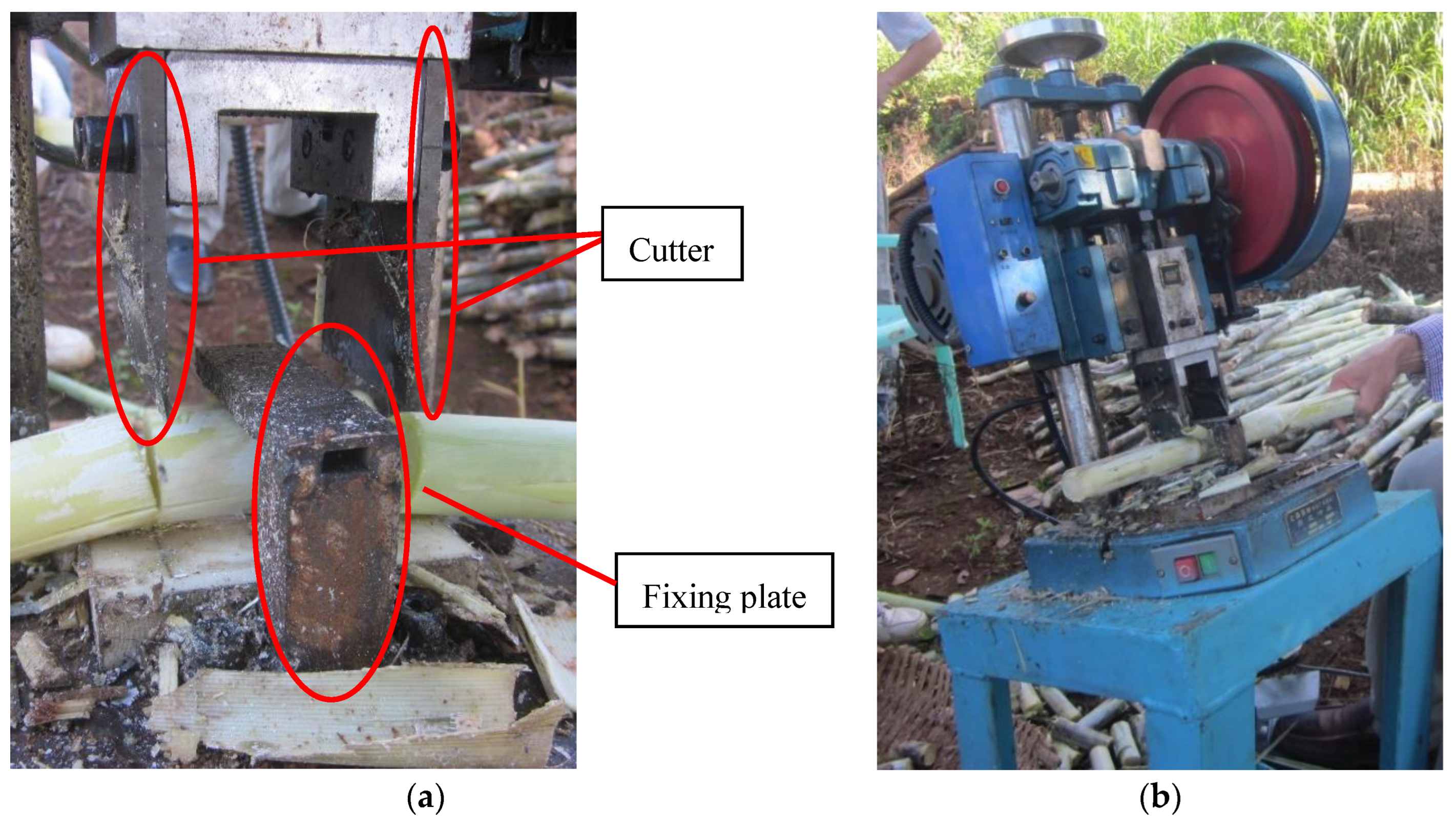
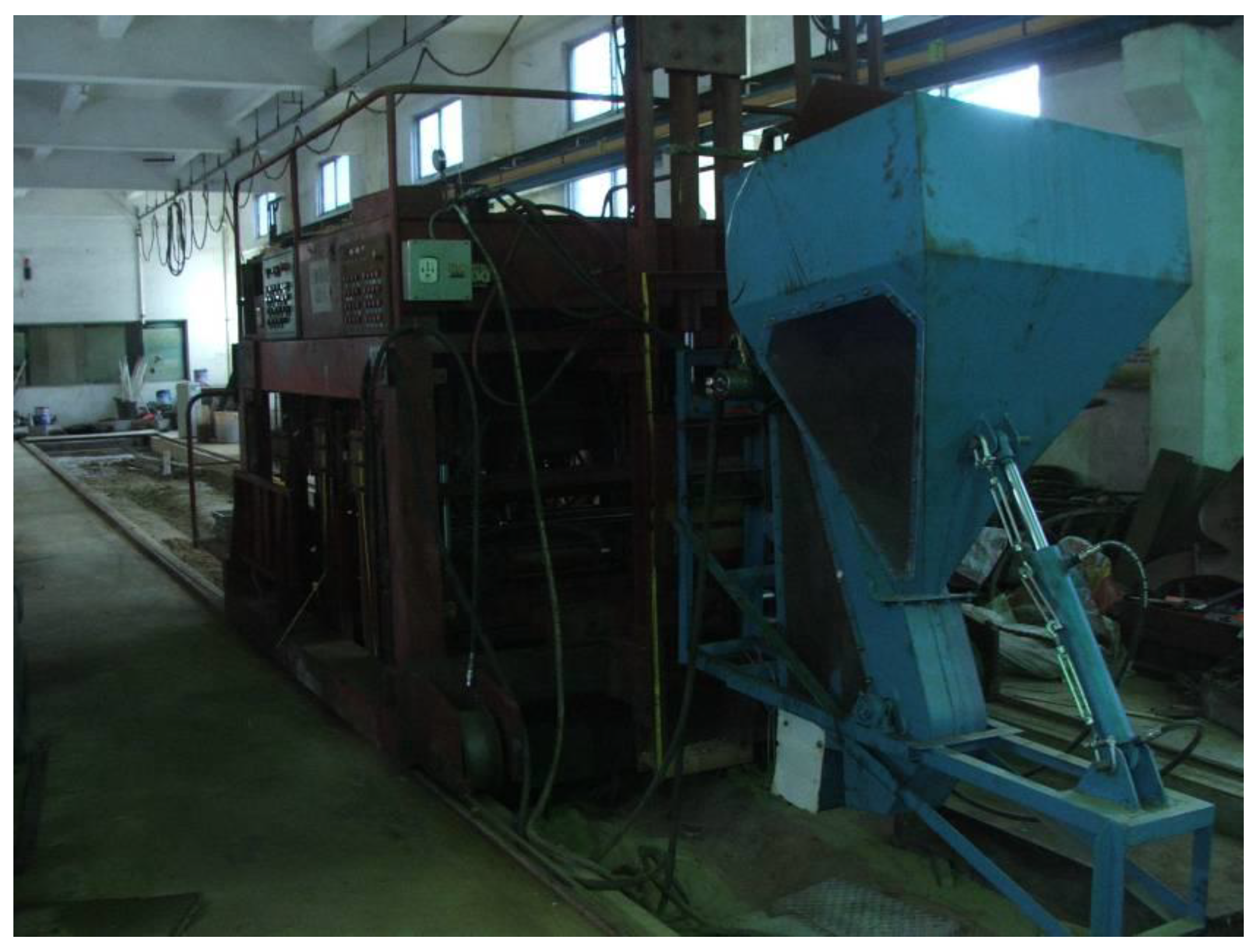
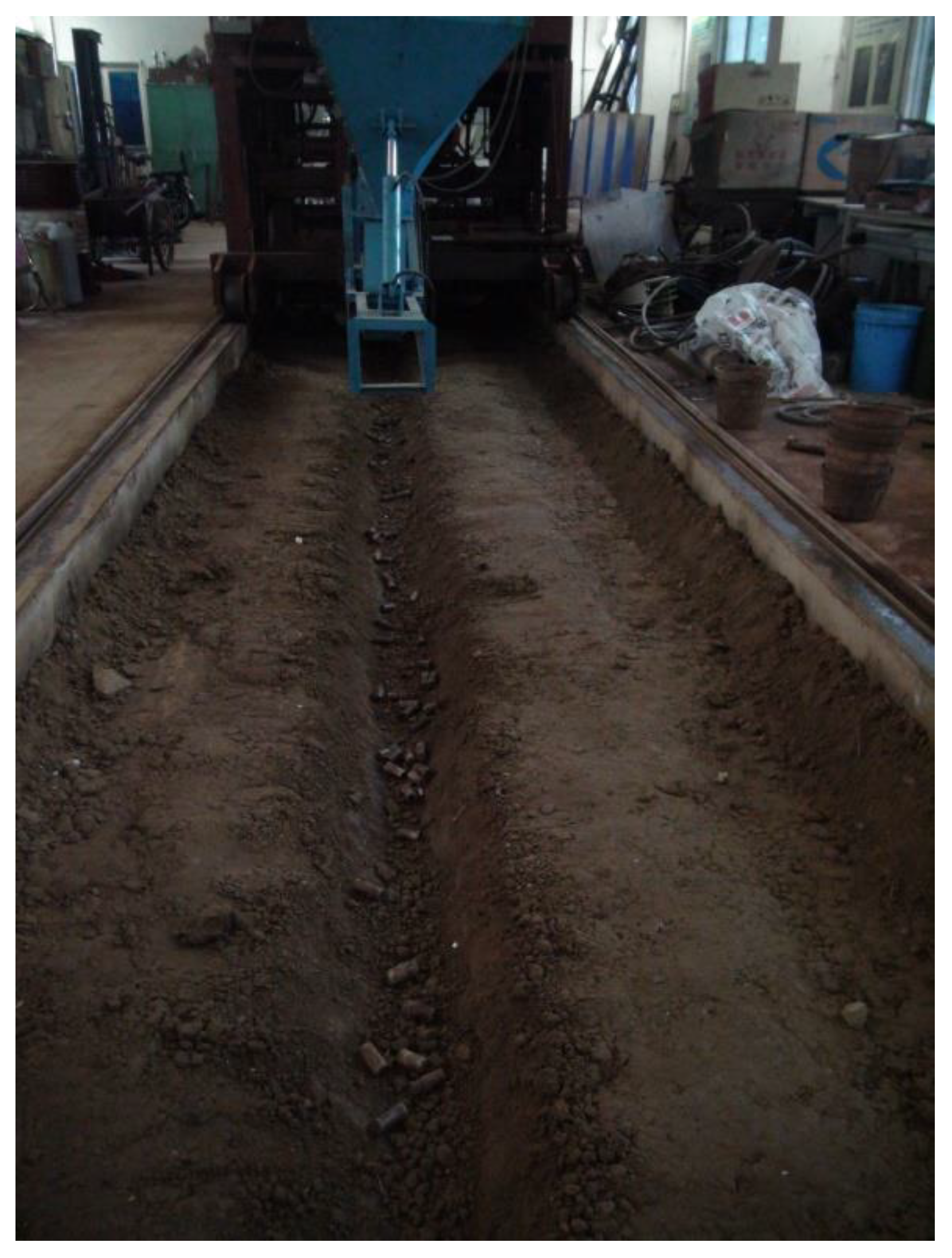

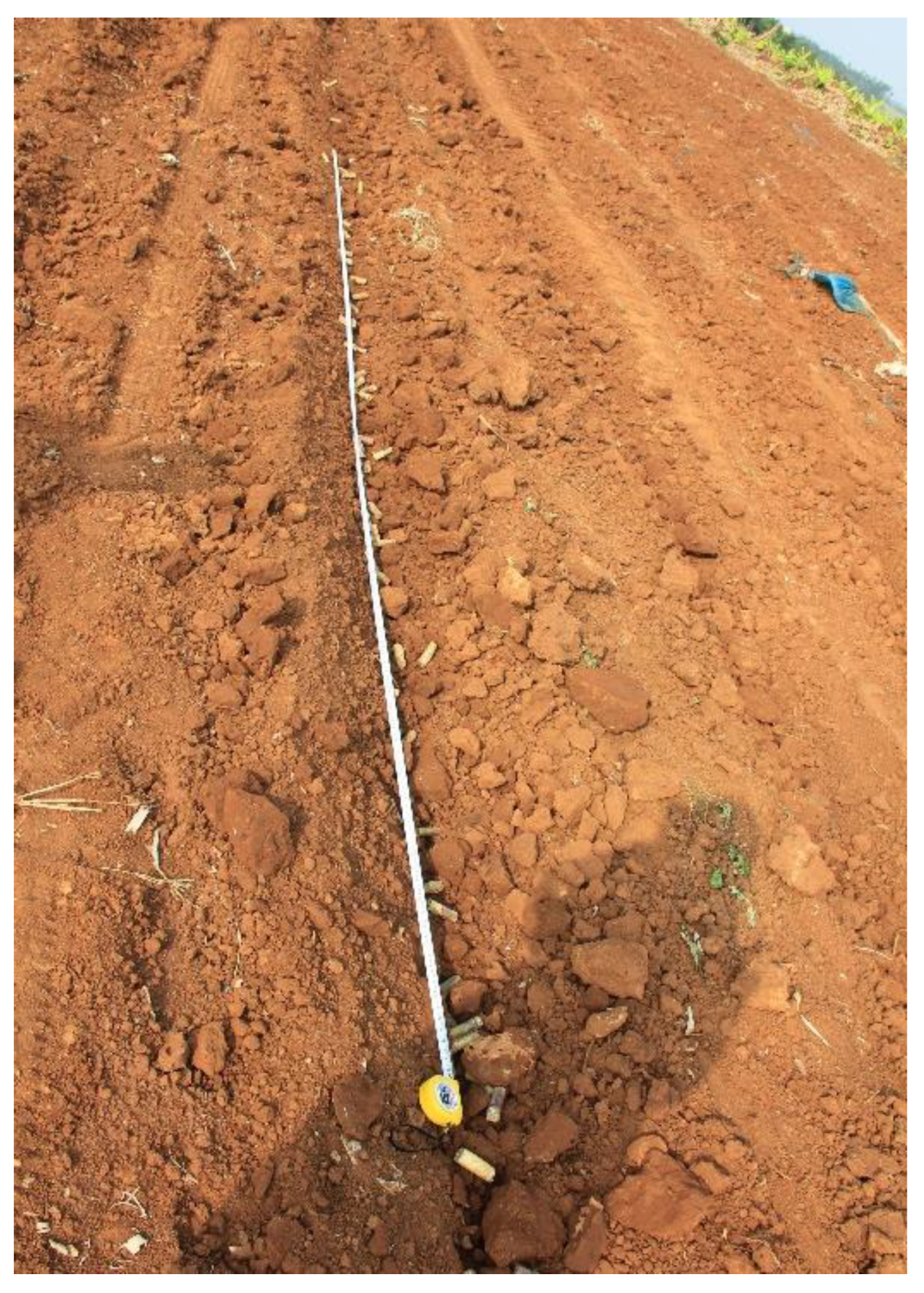
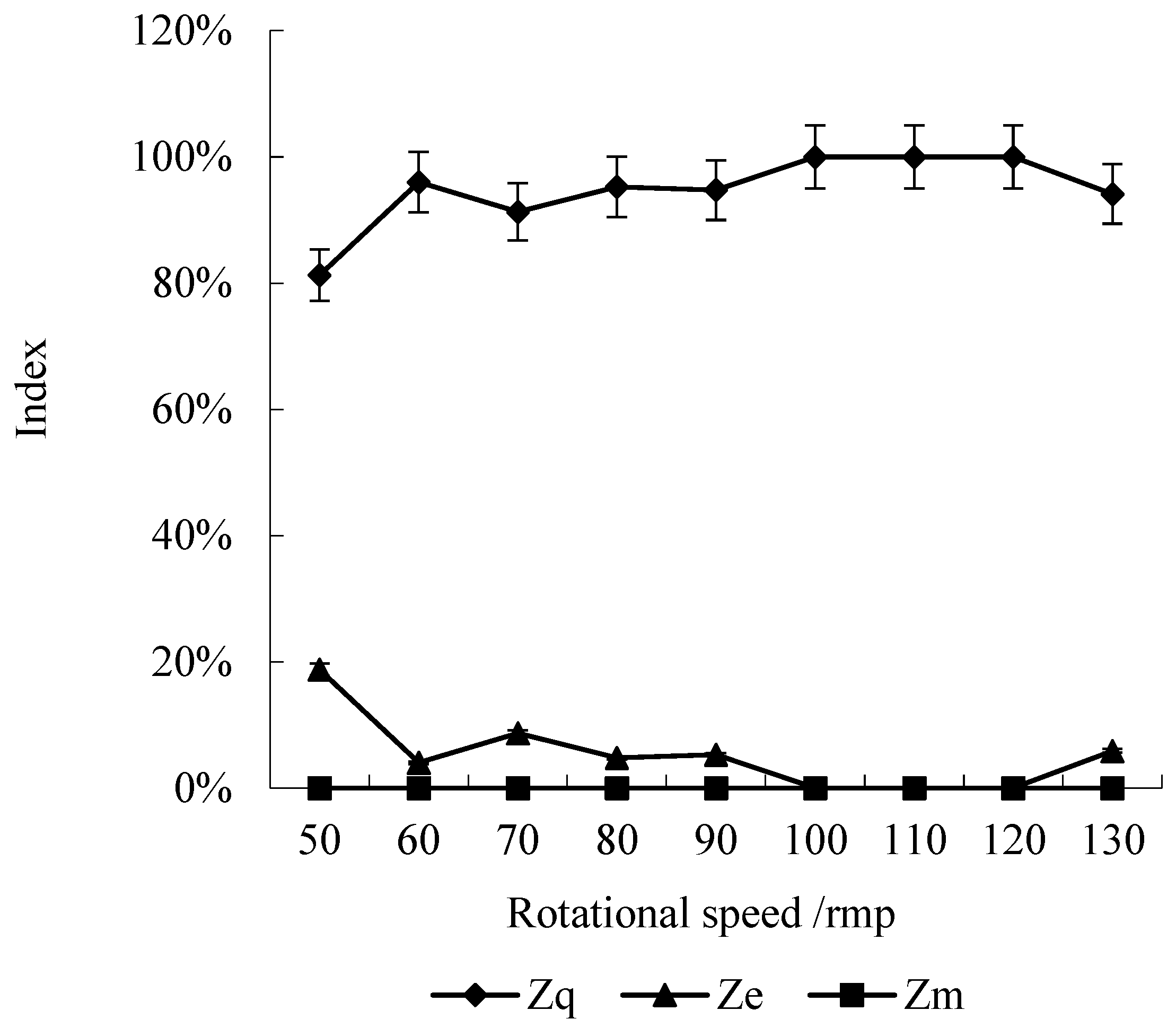
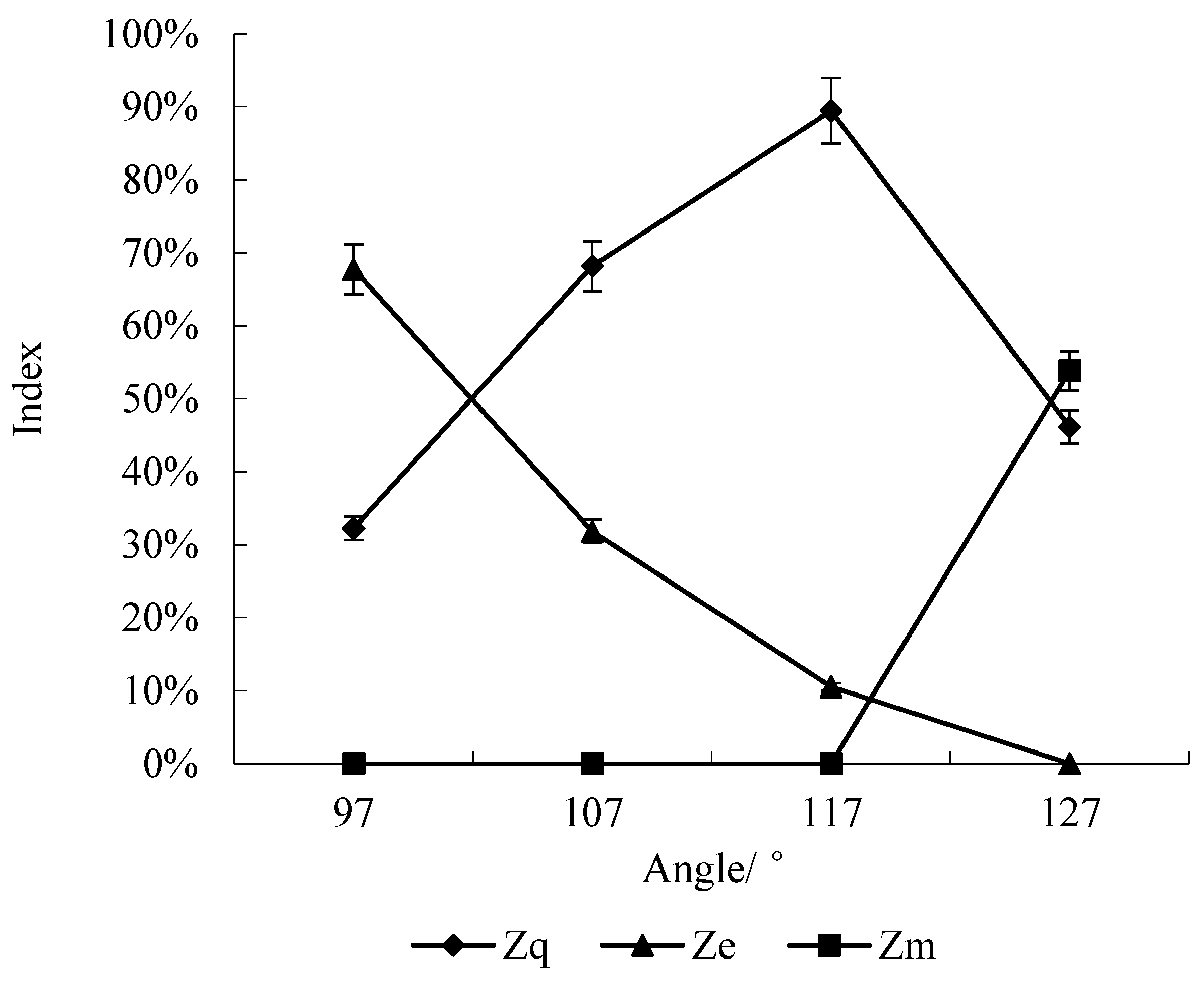
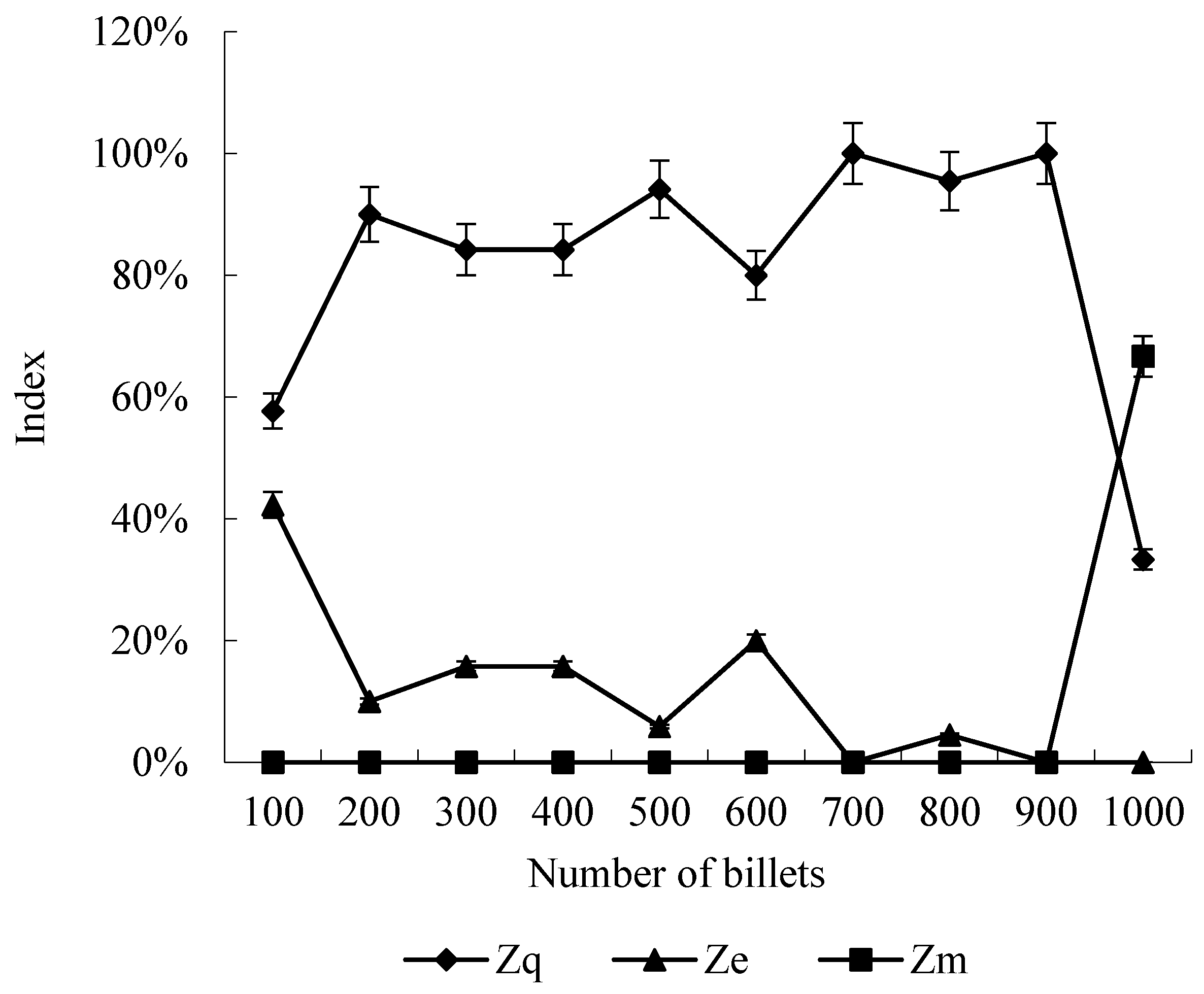
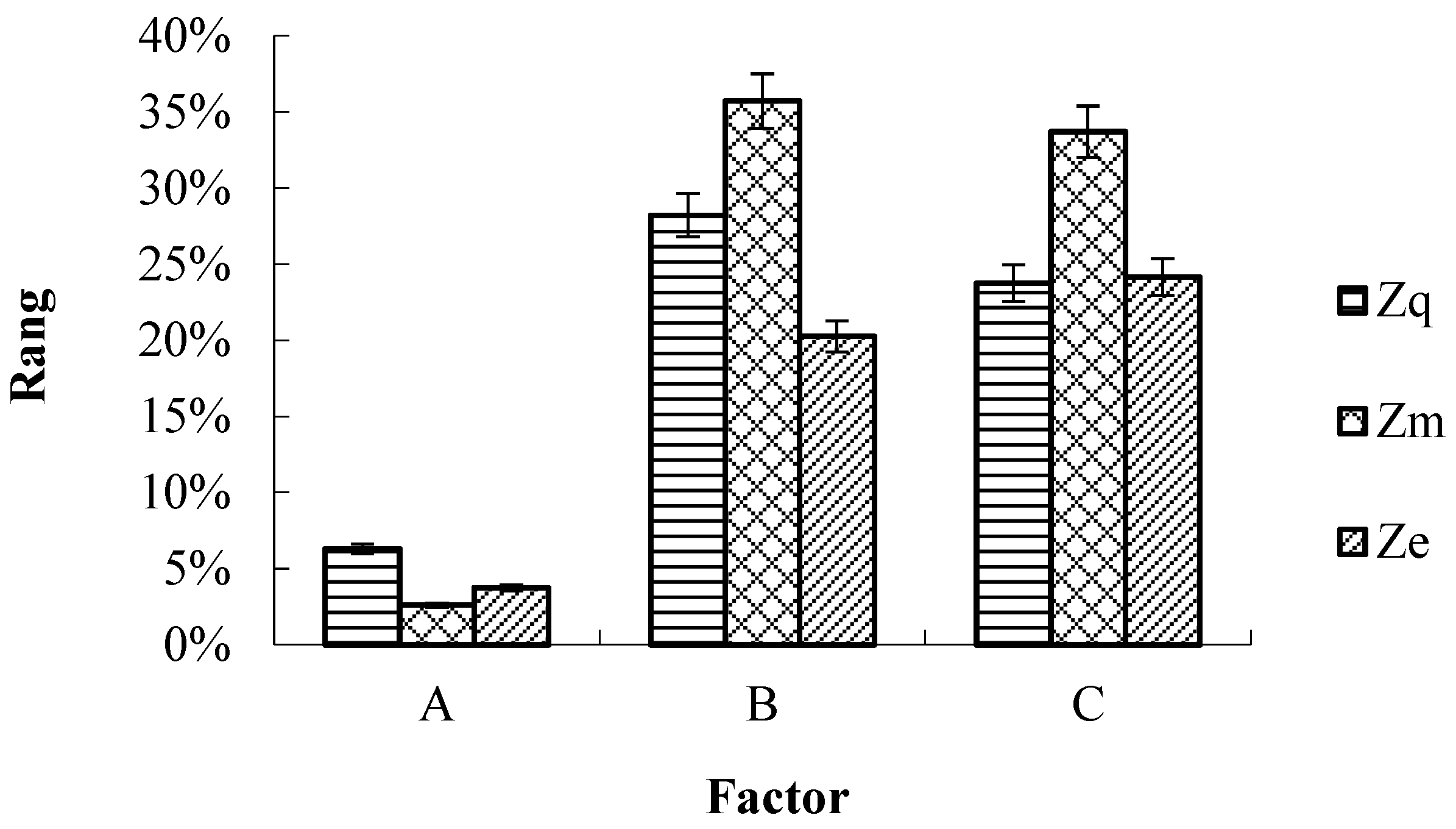


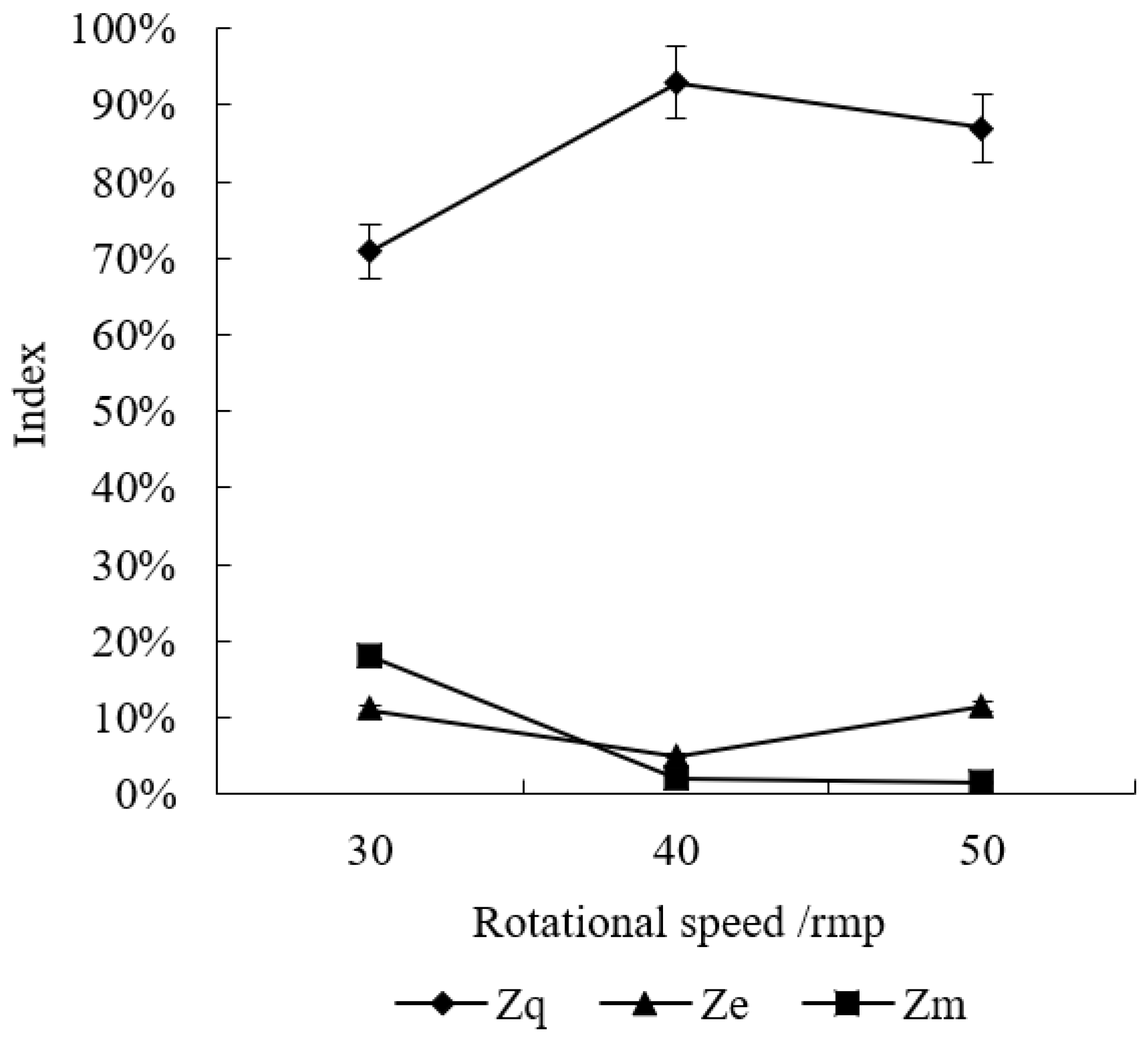
| Level | Factor | ||
|---|---|---|---|
| Rotational Speed of Rake Bar Chain A/rpm | Angle of Rake Bar Chain B/° | Number of Billets C | |
| 1 | 70 | 107 | 200 |
| 2 | 90 | 117 | 500 |
| 3 | 110 | 127 | 800 |
| Rotational Speed /Rpm | Sample Number | CV | Min | Max | |
|---|---|---|---|---|---|
| 50 | 32 | 2.614 | 32.43% | 1.00 | 14.00 |
| 60 | 25 | 2.330 | 20.22% | 6.00 | 15.00 |
| 70 | 23 | 2.651 | 20.60% | 8.00 | 18.00 |
| 80 | 21 | 2.804 | 19.31% | 10.00 | 20.00 |
| 90 | 19 | 3.142 | 19.32% | 11.00 | 21.00 |
| 100 | 15 | 2.658 | 13.25% | 16.00 | 27.00 |
| 110 | 16 | 3.633 | 17.77% | 16.00 | 28.00 |
| 120 | 14 | 3.342 | 14.31% | 18.00 | 28.00 |
| 130 | 17 | 4.535 | 19.52% | 14.00 | 33.00 |
| Angle /° | Sample Number | CV | Min | Max | |
|---|---|---|---|---|---|
| 97 | 31 | 2.693 | 28.59% | 5 | 14 |
| 107 | 22 | 3.554 | 26.15% | 7 | 20 |
| 117 | 19 | 4.221 | 25.62% | 7 | 25 |
| 127 | 13 | 5.464 | 17.20% | 22 | 38 |
| Number of Billets | Sample Number | CV | Min | Max | |
|---|---|---|---|---|---|
| 100 | 26 | 4.308 | 39.86% | 1.00 | 19.00 |
| 200 | 20 | 2.458 | 17.07% | 10.00 | 19.00 |
| 300 | 19 | 4.045 | 25.53% | 10.00 | 23.00 |
| 400 | 19 | 4.525 | 28.56% | 7.00 | 24.00 |
| 500 | 17 | 4.106 | 22.96% | 7.00 | 24.00 |
| 600 | 20 | 4.256 | 28.95% | 8.00 | 25.00 |
| 700 | 19 | 2.594 | 15.45% | 12.00 | 21.00 |
| 800 | 22 | 5.402 | 27.96% | 11.00 | 30.00 |
| 900 | 16 | 4.335 | 16.96% | 18.00 | 33.00 |
| 1000 | 12 | 7.292 | 21.09% | 21.00 | 45.00 |
| No | A | B | A×B | A×B | C | A×C | A×C | B×C | B×C | Zq | Zm | Ze |
|---|---|---|---|---|---|---|---|---|---|---|---|---|
| 1 | 2 | 3 | 4 | 5 | 6 | 7 | 8 | 11 | ||||
| 1 | 1 | 1 | 1 | 1 | 1 | 1 | 1 | 1 | 1 | 25.00% | 75.00% | 0.00% |
| 2 | 1 | 1 | 1 | 1 | 2 | 2 | 2 | 2 | 2 | 4.17% | 95.83% | 0.00% |
| 3 | 1 | 1 | 1 | 1 | 3 | 3 | 3 | 3 | 3 | 4.00% | 96.00% | 0.00% |
| 4 | 1 | 2 | 2 | 2 | 1 | 1 | 1 | 2 | 3 | 37.93% | 62.07% | 0.00% |
| 5 | 1 | 2 | 2 | 2 | 2 | 2 | 2 | 3 | 1 | 8.33% | 91.67% | 0.00% |
| 6 | 1 | 2 | 2 | 2 | 3 | 3 | 3 | 1 | 2 | 0.00% | 94.44% | 5.56% |
| 7 | 1 | 3 | 3 | 3 | 1 | 1 | 1 | 3 | 2 | 12.50% | 87.50% | 0.00% |
| 8 | 1 | 3 | 3 | 3 | 2 | 2 | 2 | 1 | 3 | 0.00% | 93.33% | 6.67% |
| 9 | 1 | 3 | 3 | 3 | 3 | 3 | 3 | 2 | 1 | 0.00% | 7.14% | 92.86% |
| 10 | 2 | 1 | 2 | 3 | 1 | 2 | 3 | 1 | 1 | 31.82% | 68.18% | 0.00% |
| 11 | 2 | 1 | 2 | 3 | 2 | 3 | 1 | 2 | 2 | 9.09% | 90.91% | 0.00% |
| 12 | 2 | 1 | 2 | 3 | 3 | 1 | 2 | 3 | 3 | 10.53% | 89.47% | 0.00% |
| 13 | 2 | 2 | 3 | 1 | 1 | 2 | 3 | 2 | 3 | 25.00% | 75.00% | 0.00% |
| 14 | 2 | 2 | 3 | 1 | 2 | 3 | 1 | 3 | 1 | 0.00% | 100.00% | 0.00% |
| 15 | 2 | 2 | 3 | 1 | 3 | 1 | 2 | 1 | 2 | 0.00% | 81.82% | 18.18% |
| 16 | 2 | 3 | 1 | 2 | 1 | 2 | 3 | 3 | 2 | 15.00% | 85.00% | 0.00% |
| 17 | 2 | 3 | 1 | 2 | 2 | 3 | 1 | 1 | 3 | 0.00% | 93.33% | 6.67% |
| 18 | 2 | 3 | 1 | 2 | 3 | 1 | 2 | 2 | 1 | 0.00% | 13.33% | 86.67% |
| 19 | 3 | 1 | 3 | 2 | 1 | 3 | 2 | 1 | 1 | 84.62% | 15.38% | 0.00% |
| 20 | 3 | 1 | 3 | 2 | 2 | 1 | 3 | 2 | 2 | 40.54% | 59.46% | 0.00% |
| 21 | 3 | 1 | 3 | 2 | 3 | 2 | 1 | 3 | 3 | 0.00% | 100.00% | 0.00% |
| 22 | 3 | 2 | 1 | 3 | 1 | 3 | 2 | 2 | 3 | 0.00% | 100.00% | 0.00% |
| 23 | 3 | 2 | 1 | 3 | 2 | 1 | 3 | 3 | 1 | 0.00% | 100.00% | 0.00% |
| 24 | 3 | 2 | 1 | 3 | 3 | 2 | 1 | 1 | 2 | 0.00% | 100.00% | 0.00% |
| 25 | 3 | 3 | 2 | 1 | 1 | 3 | 2 | 3 | 2 | 0.00% | 100.00% | 0.00% |
| 26 | 3 | 3 | 2 | 1 | 2 | 1 | 3 | 1 | 3 | 0.00% | 71.43% | 28.57% |
| 27 | 3 | 3 | 2 | 1 | 3 | 2 | 1 | 2 | 1 | 0.00% | 0.00% | 100.00% |
| Zq | Zm | Ze | ||||
|---|---|---|---|---|---|---|
| Source | Sig | Eta2 | Sig | Eta2 | Sig | Eta2 |
| A | 0.642 | 0.105 | 0.556 | 0.136 | 0.83 | 0.046 |
| B | 0.013 * | 0.661 | 0.000 ** | 0.972 | 0.046 * | 0.536 |
| C | 0.03 * | 0.583 | 0.000 ** | 0.967 | 0.02 * | 0.625 |
| B×C | 0.001 ** | 0.885 | 0.000 ** | 0.978 | 0.465 | 0.331 |
| A×C | 0.742 | 0.198 | 0.566 | 0.282 | 0.938 | 0.086 |
| A×B | 0.169 | 0.515 | 0.124 | 0.557 | 0.161 | 0.522 |
| Zq | Zm | Ze | |||||||
|---|---|---|---|---|---|---|---|---|---|
| Factor | C1 | C2 | C3 | C1 | C2 | C3 | C1 | C2 | C3 |
| B1 | 52.85% | 82.07% | 95.16% | 0.00% | 0.00% | 0.00% | 47.15% | 17.93% | 4.84% |
| B2 | 79.02% | 97.22% | 92.09% | 0.00% | 0.00% | 7.91% | 20.98% | 2.78% | 0.00% |
| B3 | 90.83% | 86.03% | 6.82% | 0.00% | 13.97% | 93.18% | 9.17% | 0.00% | 0.00% |
| Rotational Speed (rmp) | Forward Speed (km/h) | Zq | Ze | Zm |
|---|---|---|---|---|
| 50 | 1.61 | 87.50% | 10.58% | 1.92% |
| 50 | 2.23 | 87.64% | 10.11% | 2.25% |
| 40 | 2.26 | 93.38% | 4.41% | 2.21% |
| 30 | 2.25 | 71.72% | 10.10% | 18.18% |
Publisher’s Note: MDPI stays neutral with regard to jurisdictional claims in published maps and institutional affiliations. |
© 2022 by the authors. Licensee MDPI, Basel, Switzerland. This article is an open access article distributed under the terms and conditions of the Creative Commons Attribution (CC BY) license (https://creativecommons.org/licenses/by/4.0/).
Share and Cite
Wang, M.; Liu, Q.; Ou, Y.; Zou, X. Experimental Study of the Planting Uniformity of Sugarcane Single-Bud Billet Planters. Agriculture 2022, 12, 908. https://doi.org/10.3390/agriculture12070908
Wang M, Liu Q, Ou Y, Zou X. Experimental Study of the Planting Uniformity of Sugarcane Single-Bud Billet Planters. Agriculture. 2022; 12(7):908. https://doi.org/10.3390/agriculture12070908
Chicago/Turabian StyleWang, Meimei, Qingting Liu, Yinggang Ou, and Xiaoping Zou. 2022. "Experimental Study of the Planting Uniformity of Sugarcane Single-Bud Billet Planters" Agriculture 12, no. 7: 908. https://doi.org/10.3390/agriculture12070908
APA StyleWang, M., Liu, Q., Ou, Y., & Zou, X. (2022). Experimental Study of the Planting Uniformity of Sugarcane Single-Bud Billet Planters. Agriculture, 12(7), 908. https://doi.org/10.3390/agriculture12070908







